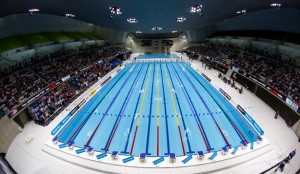Competitive Swimming
Introduction:
Like many established sports that have developed their own culture and folklore over time so too do the groups that play it. Competitive swimming serves as a model for this same type of cultural and folk development. Like a culture has folklore, swimming has shaped its own mannerisms and unique forms of communications. Although the sport has most recently grown due to the success and stardom of athletes like Michael Phelps, modern competitive swimming has a timeline of existence much like that of Basketball; it has been a part of every known summer Olympics. Likewise there are a multiplicity of items that subsist in the repertoire of gestures rituals and etiquette that are intrinsically linked to Swimming, and these are the categories of items that we elected to explore.
As a group we decided that the best method of investigation was to accrue a number of one-on-one interviews in order to best accrue a basis of items that fall under our proposed categories of folklore. All of our findings are identified to be habitual and true not only in the interviewed individuals own experiences but also their witnessings. After interviewing a wide variety of ‘swimmer’ categories from high school, club all the way up to [collegiate] alumni and coaches we found there to be numerous general trends in their experiences. We determined which trending experiences were fitting of being identified as folklore, and if fit if their trend was serious enough to progress in identifying it as an item. In conclusion we believe that the items that we are presenting come as a direct result of interview participant verification as well as thorough critical discussion to determine the importance and relevance of each item.
Items:
Conclusion:
One of the most impressive things about this project was how willing and forthcoming individuals were with their personal experiences with competitive swimming. Every individual that we talked to had numerous examples of each distinctive category of folklore that we had set out to collect and were excited to talk about them. This speaks to the love that our sources had for the topic that we were exploring, as well as the strength of this folk group. This is the same love that led to the formation of the quality folklore that we were able to collect.
Just because our sources were so forthcoming, doesn’t mean that our research is without limitations. For one thing, all of our sources were American and were people that us as the collectors had some level of a personal connection to. Our sources were definitely varied in background, age, and experience with competitive swimming but all definitely at some point shared an experience with us. So perhaps given more time we could have gone out and interviewed some international competitive swimmers or some swimmers from other areas where we have never been to and never had any direct connection with. That being said, our collection group was diverse in current status and all had different experiences with the sport so we feel as though we have a strong spectrum of sources to rely upon.
Just about every source had a very similar experience with the folklore of competitive swimming. Whether it was hand gestures such as signaling to hold a steady pace, etiquettes such as shaking competitors’ hands after a race, or pre-race rituals such as cheers, we found that every source had experience with each category of folklore. This is interesting given the diverse background of our sources. These items are passed down through generations and have spread across enough space to cover our sources and throughout time. These items have built strong connections between generations of competitive swimmers at each level and will continue to evolve as more individuals enter into competitive swimming.
Collectors: Aaron Athanas ’16, Dave Harmon ’17, Grace Herron ’19, Misha Tovmashenko ’18, Nicholas Whalley ’17.
Keywords: Swimming, Competitive, Swimmers, Folklore, Rituals, Traditions, Etiquette
Russian 13: Vampires, Witches and Firebirds, Spring 2016
Victoria Somoff, Mikhail Gronas

